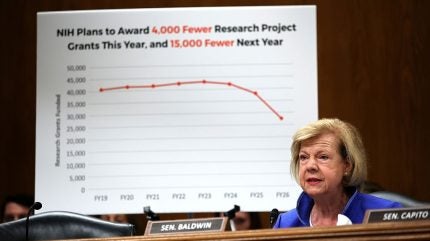
There are no shortage of reasons for foreign companies to invest in the US. It is the world’s biggest consumer market, it is where start-ups have the most access to funding, and an investment within US borders is increasingly seen as necessary to circumvent tariffs. It has also, for decades, been the world’s preeminent research destination.
However, proposed cuts to research and development (R&D) funding, immigration restrictions and the politicisation of certain fields mean the country could lose its leading status in the long term.
Barry Broome, CEO of the Greater Sacramento Economic Council, told this publication that out of all the disruptions of the past year – tariffs, the government shutdown, immigration crackdowns – the funding cuts to research are his biggest concern. They are “silent economic killers”, he says, whose effects would only be felt a few years from now.
Download sample pages of selected reports
Explore a selection of report samples we have handpicked for you. Get a preview of the insights inside. Download your free copy today.
In recent years, the US Government has funded around 40% of basic research, the type of curiosity-led experimental or theoretical work that is pursued without any specific application in view. If you are reading this, the internet connection you are using was developed through US Government-funded basic research. So were AI, smartphones, the global positioning system (GPS) and many more inventions.
In 2024, nearly half of US federal funding into basic research went towards the Department of Health and Human Services (HHS), primarily to the National Institute of Health (NIH). In second place was the National Science Foundation (NSF), an independent federal agency that funds science, technology, engineering and mathematics (STEM) research. Now, in 2025, the future of these agencies is uncertain as proposed funding cuts have disrupted ongoing research and the distribution of new grants. The Trump administration has proposed to reduce the NSF’s funding by over 50% and the NIH’s by 40%.
The White House has justified these changes through claims that agencies were “wasting taxpayer dollars on frivolous grants”, particularly in programmes aimed at broadening diversity, equity and inclusion (DEI). However, disruption to funding has extended far beyond these areas, with much of the country’s research community saying that the cuts could have long-term repercussions for the US’ R&D ecosystem if applied in full. Universities are also facing financial strain from a decreased intake of international students, who pay higher fees.
“Research happening outside of the US means the world will see breakthroughs and new tech that could have been pioneered in the US happen elsewhere. Dedicated experts in their fields will also move to where they can do their research, even if that is outside the US, causing brain drain,” Steven Schuchart, GlobalData enterprise networking principal analyst, says. “International students and even some American students will also gravitate elsewhere, to universities and research institutions that can fund them.”
What research is being targeted and why?
As of November 2025, more than 3,800 research grants from the NIH and the NSF have been cancelled or frozen, according to watchdog organisation GrantWatch.
A White House fact sheet outlining the administration’s justifications for the funding cuts cites a 2024 study from Republican Senator Ted Cruz. The study claimed that the NSF allocated more than $2bn to research projects “that promoted neo-Marxist perspectives or DEI tenets” under former President Joe Biden.
Grants going towards the widening of STEM education and participation did increase under the Biden administration. In June 2021, Biden signed an executive order (“Diversity, Equity, Inclusion, and Accessibility in the Federal Government”) directing federal agencies to develop and implement DEI strategies. Whether these were “neo-Marxist” is naturally a more subjective determination. The report’s methodology says it filtered projects by keywords and phrases related to DEI. These included ‘clean energy’, ‘climate change’, ‘socially relevant’, ‘female’ and ‘ESG’, among others.
In February 2025, Senator Cruz released the database of projects identified in the earlier report as advancing “DEI or […] neo-Marxist class warfare propaganda”. Some of these projects were aimed at improving the safety of self-driving cars, finding new ways of synthesising new medications and researching protein malfunctions that can lead to cancer.
As of May 2025, most cancelled funding in the NSF from in-progress grants was in STEM education, at $656m. However, the decline in the issuing of new grants was broader, hitting maths, physics and chemistry research the hardest, with $289m in new funding denied. Over a third of the terminated NSF grants appeared in Senator Cruz’s report.
The NIH has also faced major disruption from the cancellation of grants and proposed cuts. A recent study found that hundreds of government-funded clinical trials, with more than 74,000 patients, were disrupted following the termination and freezing of grants earlier this year. GrantWatch estimates that paused or terminated NIH grants have caused a $2.3bn loss.
The administration says it is prioritising other fields including AI, biotechnology, national security technology, nuclear energy, quantum science and space exploration. While there has been increased funding to these sectors, including through partnerships with the private sector, these fields have also been affected. In September, a Miami-based AI Institute working on improving weather forecasting methods had $20m in funding from the NSF halted.
A decline in federal funding to organisations that fund basic research is particularly damaging because it creates a vacuum that would likely not be filled by the private sector, which is incentivised to pursue research with commercial products in view.
While it is difficult to calculate the economic loss of less research funding, economists can calculate the return on investment of R&D projects. A study from the Federal Reserve Bank of Dallas, for example, suggests that non-defence government R&D funding has been responsible for 20–25% of the US’ private sector productivity growth since the Second World War.
“You just saw the Nobel Prize in Physics for quantum information science. This work was done at [UC] Berkeley 30 years ago, and all the excitement about quantum computing is traceable back to that fundamental research. Nobody except the federal government is going to fund that kind of fundamental research. So if the federal government doesn’t do it, it doesn’t happen in the United States,” Simon Atkinson, vice-chancellor of research at UC Davis, tells Investment Monitor.
When asked by this publication for comment and for the methodology that has been used to decide which grants will be cancelled or paused, the NSF declined to comment.
The NIH responded to the same questions with the following statement:
“NIH is committed to restoring the agency to its tradition of upholding gold-standard, evidence-based science, and is carefully reviewing all grants to assure the agency is addressing the United States chronic disease epidemic. NIH and HHS are taking actions to prioritise research that directly affects the health of Americans. We will leave no stone unturned in identifying the root cause of the chronic disease epidemic as part of our mission to make America Healthy Again.”
International student strain
Aside from federal funding cuts, universities are also facing a drop in international students due to increased restrictions and heightened protocols around visas. It is a twofold problem for universities, as over the years international students have become an important source of income as they pay higher fees, and it narrows the talent pool for future researchers.
This autumn, new international student enrolment in US universities dropped 17% compared to previous years. Universities highlighted different reasons for this, such as visa issues and travel restrictions. In June 2025, the US State Department started requiring student visa applicants to make their social media accounts public for “any indications of hostility toward the citizens, culture, government, institutions or founding principles of the United States”.
While incoming international students are decreasing, the funding cuts and visa changes are also affecting current students, whose options for staying in the US are narrowing. For example, the H1-B visa was a popular option for highly skilled researchers, but with the $100,000 fee, its future is uncertain. Another popular option for graduate students was optional practical training, which allowed students to work for a year (or two if they were in STEM) following course completion to pursue practical experience.
“I think there are a lot of students who are asking themselves whether a research career is the right thing for them, and that is going to have a really long-term damage to the US,” Atkinson says, highlighting that the cuts affect both international and domestic students.
Options going forward
Agencies and lawmakers now have until January 2026 to negotiate what cuts will take place at the research agencies. If the government does not agree on a budget, there could be another shutdown.
There has been pushback to the proposed cuts from both Republicans and Democrats. This past summer, bipartisan Senate committees discussed opposition to the wide-ranging cuts, suggesting they could reject the president’s proposal.
“I think there is an understandable reluctance on the Republican side to be very publicly opposed to the president’s agenda,” says Atkinson, who has travelled to Washington, DC, multiple times over the past year, “but, in private, or at least when it comes to research funding, they understand the importance and we have good arguments with them about things they care about like national security.”
While the threats have already caused some students to reconsider pursuing a research career, Schuchart highlights there is time to turn it around.
“It is a reversible problem – providing the US Government can act quickly enough. If research funding for tech is curtailed long-term, there will be permanent damage to the ability of US tech to keep up with international rivals.”
Unlock up to 35% savings on GlobalData reports
Use the code at checkout in the report store
-
20% OFF
Buy 2 reports
Use code:
Bundle20
-
25% OFF
Buy 3 reports
Use code:
Bundle25
-
30% OFF
Buy 4 reports
Use code:
Bundle30
-
35% OFF
Buy 5+ reports
Use code:
Bundle35
Valid on all reports priced $995 and above. Cannot be combined with other offers.
Still deciding what will work best for your business?
Ask our experts for help.
Enquire before buying



